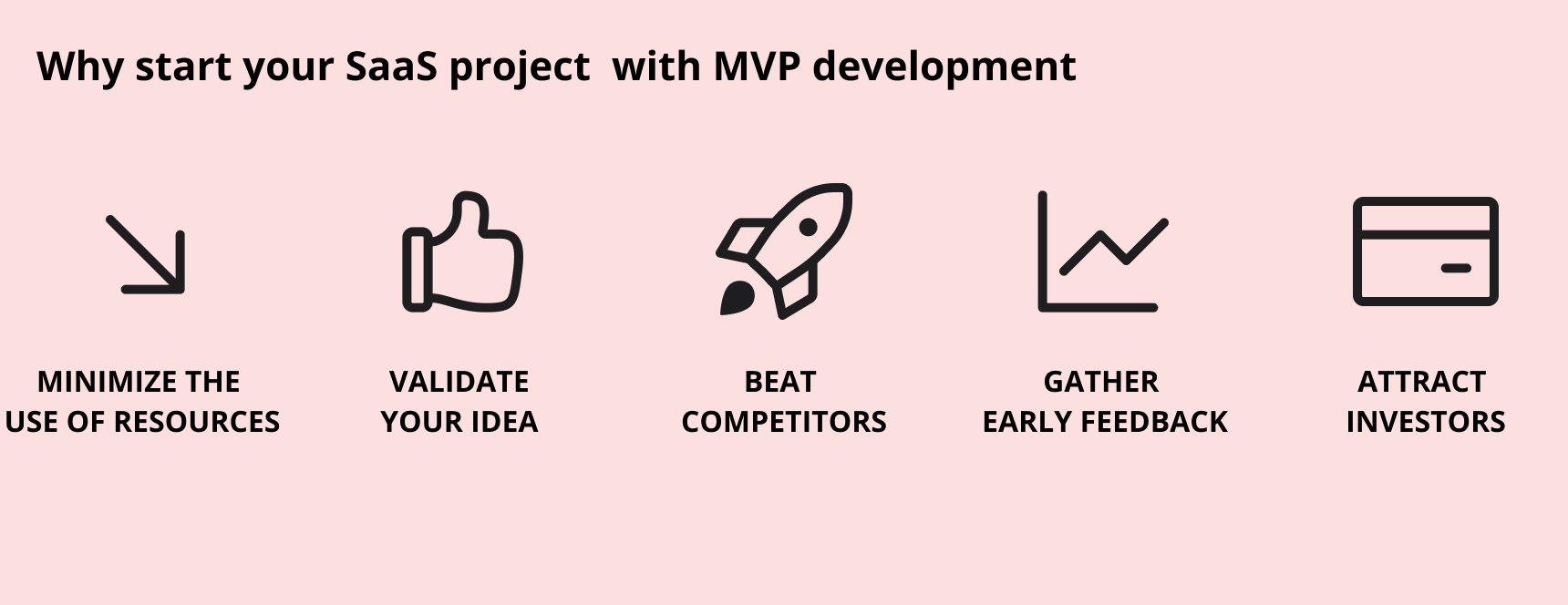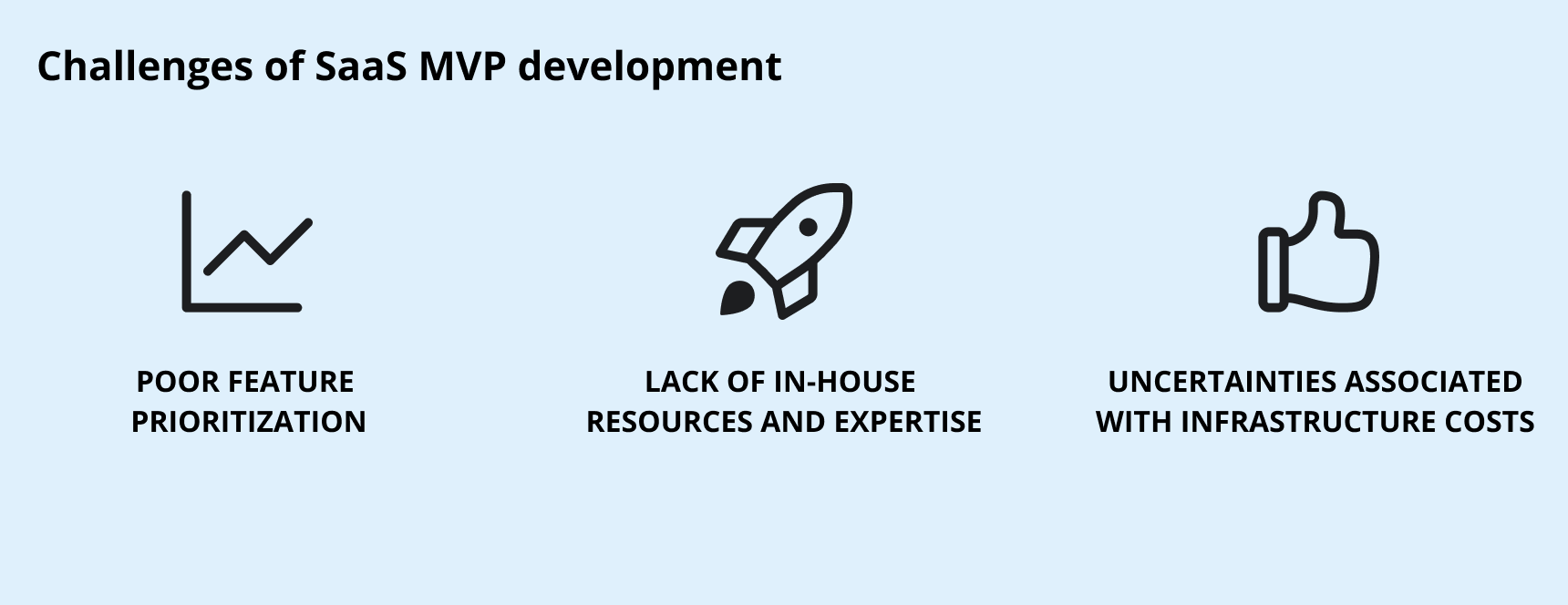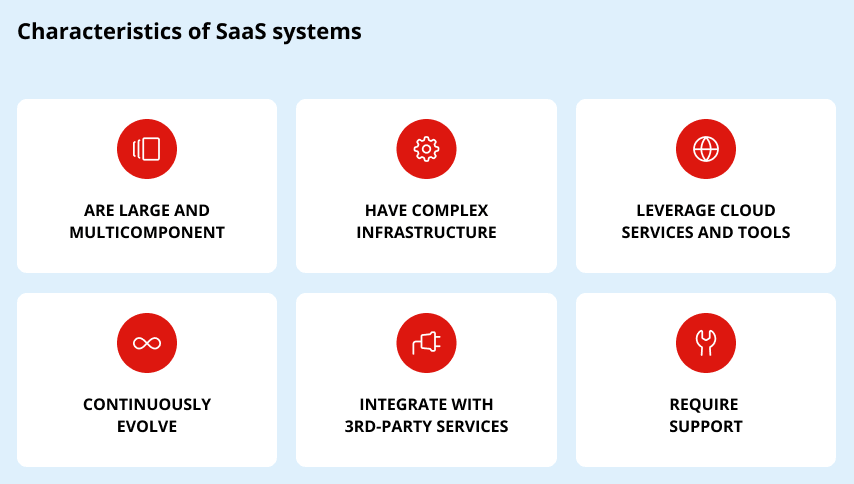Guide to SaaS MVP Development
You want to build a profitable SaaS. SaaS that will carve its niche, beat the competition, or even create a category of its own. And to make sure it will solve the real needs of real people, you consider building a SaaS MVP first.
Makes sense. Building a large SaaS platform is a costly venture. Starting your product with MVP is a proven way to validate your idea using minimum resources and time. But even an MVP stage hides many pitfalls that drown the majority of SaaS startups. (Remember Quibi?)
This is why we put together this guide to SaaS MVP development. It will walk you through the strategies for building an MVP for SaaS without draining your budget and losing sight of your goals. You will learn:
- Why MVP is good for your product and for your pocket.
- Which top SaaS companies used the MVP approach to win their markets.
- How to build an MVP for SaaS in 5 steps.
- What challenges to expect in your journey, and how to solve them.

Quick answer: Because you don’t want to fall flat and build something that no one needs.
Yes, SaaS market is thriving. On average, a modern company uses 130 SaaS applications (BetterCloud, 2022). Moreover, 94% of IT executives plan to up the use of SaaS in their operations in the next two years (Torii, 2022). Yet despite growing interest, more than 90% of software companies won’t last longer than 3 years failing to find product-market fit and build a sustainable business strategy.
Starting with a SaaS MVP helps companies escape this fate and test their business ideas in the field without investing too much into development. Let’s see how exactly this works.
Minimize the use of resources
Software as a Service is not a website you can churn out using no-code tools and builders. SaaS is a scalable feature-rich cloud-based software provided on demand over the web. It has a complex infrastructure and, as a rule, integrates with multiple third-party services and tools. The development of a fully-fledged SaaS costs tens and hundreds of thousands of dollars. And it never stops.
The average SaaS MVP cost example falls between $50,000 and $150,000 depending on complexity, niche, and available resources.
Creating an MVP for a SaaS platform is a cost-effective alternative that will help you roll out a stripped-down version of your product without exhausting your budget. It requires way less manpower and infrastructure resources. And it usually takes somewhat between 3 to 6 months depending on the complexity and planning.
Validate your idea
New SaaS ventures are popping up like mushrooms after a summer rain. But only a few survive the trial of time and changing market. The goal of MVP is to help you validate your idea in a real market environment with a real target audience early on, and then build your strategy based on what you’ve learned.
Beat competitors
When you work in a competitive SaaS market, you want to get your product out the door before anyone else does it before you. Developing an MVP for SaaS allows you to hit the ground running once you have clarified your idea and done your research. The rest you will figure out after you get feedback from your customers. And on that note…
Gather early feedback
You need feedback from your target audience to build your SaaS product roadmap. The sooner you get it, the better you understand your market and align your strategy to the needs of your audience. And MVP in SaaS helps you do that with minimum risks. In just a minute, we will talk about how Dropbox and Buffer’s founders used MVP feedback to turn their business ideas into legendary products.
Attract investors
SaaS MVP can save you money and get the cash flowing. You can use it to pitch your idea to investors more confidently than if you had only a Keynote presentation and a laser pointer. Or you can work out an effective pricing model and start charging users early on to measure the demand. Just as Basecamp did when they rolled out the first version of their project management SaaS.
Minimal viable product has taken different forms in the history of great SaaS products. Here are a few outstanding SaaS MVP examples that may challenge your idea of an MVP.
Basecamp
Basecamp was born as an in-house tool for a design studio 37signals. According to the origin story by the founder Jason Fried, they built Basecamp to close an acute need for an effective project management system that was simply missing from the market in the early 2000s. And since they designed it for the audience they knew best – themselves – they picked just the right features for the job – to-do lists, milestones, and message boards. No fancy or needless perks.
Soon the studio’s clients started asking where they could get this tool, and this is how it all began. As we’ve mentioned already, Basecamp started charging users early to watch the demand from paying customers. They set a yearly revenue goal, which they surpassed in only 6 weeks after launching an MVP.
Dropbox
Basecamp is a classic example of a SaaS business focused on solving a real existing problem. Unlike Basecamp, Dropbox did not hit the jackpot at the first pitch. And the second. And the third. The idea of a seamless file-sharing service simply didn’t stick with investors.
Until the founder of Dropbox Drew Houston created an explainer video with a demo that showed how Dropbox works in 3 minutes. The product itself was at the beta stage back then, and it was too complex to demonstrate from a technical standpoint. So Drew Houston decided to share the experience of using a Dropbox MVP. And even though it wasn’t exactly a minimal viable product, it did the trick. After the release of the video, the Dropbox team woke up to 75k people on the waiting list. The rest you know.
Buffer
Buffer is another MVP example that doesn’t fit into the classic concept of a minimal viable product. But it teaches a valuable lesson about the crucial role of feedback in the success of SaaS.
Joel Gascoigne, the founder of Buffer, built a two-page website to ask people if they would use a social media scheduling application. His goal was to validate if Buffer would be useful to anyone. He then applied the feedback he received to build a SaaS MVP (in only 7 weeks) that would later turn into a number-one tool for marketers around the world.
Basecamp, Dropbox and Buffer had different approaches to MVP development. And in our experience, this journey is unique for every company depending on goals, resources, and expertise. Next, we offer you a go-to framework you can use as a starting point to launch an MVP for SaaS product. Go through, adjust, and tweak it to build a successful SaaS MVP.
Looking for a skilled SaaS MVP development company?
We will help you design and develop a quality MVP version of your SaaS while keeping a laser focus on your delivery and budget goals.
SAAS DEVELOPMENT SERVICES
Make research
Research is essential in every software product development, and MVP is not an exception. The result of this research will form the backbone of many decisions you will make, including user experience, integrations, must-have features, pricing models, etc. Here are a few key areas to focus your research on.
User research
When it comes to user research, the sky is your limit. The more you can learn about your target audience, the better. Myriad business analysis techniques such as user personas, interviews, focus groups, and data analytics will help you understand the pain point, expectations, likes and dislikes of your potential users.
Competitor analysis
Unless you work on an MVP for a SaaS application that will be the first in its niche, you already have competitors to analyze and learn from. Use competitor analysis to study what has already been done in the market, and spot gaps and mistakes. Then come up with your own USP.
Domain research
Gather domain knowledge to better understand your market and your audience. It will show you how things work in your niche and what technologies, services, and solutions are in use. Moreover, it will give you an idea of what your audience expects from your SaaS.
Gather and prioritize requirements
Homework is done, and you can now get down to business. Based on the information you’ve gathered at the research stage, you can define functional (features) and nonfunctional (performance) requirements, identify your unique value proposition, and document and communicate requirements to your team and stakeholders.
Effective feature prioritization is one of the most complex parts of this journey. Because when you develop an MVP for SaaS, you have to make a lot of cuts and tradeoffs between desired functionality and limited resources and time. If you are looking for ideas, check out this guide on hands-on techniques for prioritizing product requirements.
Choose your toolset and integrations
Third-party services, reusable modules, APIs and integrations will help you speed up the app development process and save you a ton of money. At this stage, senior tech specialists perform technical analysis to define technologies and cloud tools, choose an architectural approach, pick integrations, select analytics tools, and make other important decisions concerning the technical aspects of your project.
Design, build and test your SaaS MVP product
The iterative approach is an ideal strategy to create an MVP for SaaS software. It allows you to develop a SaaS system in short cycles, test frequently and keep tabs on the process. More importantly, it gives you the flexibility to quickly amend the scope if needed.
Keep in mind that an MVP is not a prototype, not a rough and buggy version of your system. It’s a viable market-ready product that you can give to your audience to try and leave feedback. So failing to build a decent quality MVP at this step may prevent you from properly validating your business idea.
Gather feedback and iterate
Your product is out, and you start getting feedback. Using various metrics and analytics tools, you can now see how your product is received in the market. Based on these results and the feedback from early adopters, you can make data-driven decisions on your SaaS product strategy, add new features, and expand your services.
Now that we have talked about how to create a SaaS MVP, let’s walk through the challenges you may encounter on the way and strategies to solve them.

Poor feature prioritization
This is one of the biggest challenges of any MVP project. It may be hard to decide between must, should and cloud have features from the start, especially if you don’t have enough information about your market and your audience. As a result, it can lead to increased costs, scope creep, and long time-to-market.
If you don’t want to fall into this trap, first, use the proven feature prioritization frameworks we’ve mentioned before. And second, make sure your MVP for a SaaS application is also a minimum valuable product (MVaP). MVaP extends the idea of MVP as not only a viable but also a valuable product that brings:
- value to end users: stands out and solves a problem other products can’t (or solves it better)
- value to budget: allows you to bring a useful product to the market within your budget
- value to business: allows you to test your business idea and gather data to move forward with your product strategy
Lack of in-house resources and expertise
If you want to create MVP for SaaS startup, you need to have solid expertise and tech skills to design, engineer, and support it from day one. Because SaaS is not a website, it’s a complex cloud-based software. In many cases, however, tight budgets and delivery deadlines make it hard for startups to put together a decent tech team.
Outsourcing SaaS development to an experienced provider is an effective solution to this problem. This approach helps startups quickly set up development resources or augment their teams without losing months on recruiting and training. Along with speed, this approach also provides flexibility and scalability to ramp up the team as the project grows.
Build and scale your SaaS with a team of experts
Quickly add missing tech skills to your SaaS project without burning your budget.
SaaS application development servicesHard to estimate infrastructure costs
How many people will use your SaaS in the first week? In the first month? At the same time? How will your system scale with the growing load?
SaaS is a highly scalable cloud application that often serves hundreds, thousands, and in some cases, millions of users daily. Naturally, when you are at the start line of building an MVP for a SaaS platform, or even in the locker room, you can only guess how much load it will bear.
Your tech team can give a rough estimate based on their experience and figure out how to implement scalability, reliability, and performance requirements. This will impact the cost of tools and infrastructure. But because of this uncertainty, there is still a risk of under or overspending on infrastructure and resources.
There are a few strategies that help reduce these risks. For instance, engineers use stress and load testing to determine an optimal setup for secure and reliable operation. DevOps monitoring tools help track the use of pay-as-you-use computing resources and eliminate waste.

Bring your business idea to life with a quality MVP version of your SaaS product. Without struggling with a tech talent shortage and budget constraints. As a mature tech company with over a decade of experience in custom software development, we can help you transform your vision into a market-worthy high-grade MVP.
Among the companies that trust their SaaS products to our engineers are:
- An award-winning Spain-based travel tech SaaS that partners with Digiteum to scale their .NET team for vacation rental management software development.
- A global HR and payroll services provider that works with our senior UX/UI design team to deliver superior user experience on two SaaS platforms.
- A US retail startup that assigned Digiteum to create MVP for SaaS software for retailers, made an exit, and merged with a large eCommerce platform KIBO.
- A Finnish IT company that hired Digiteum to build SaaS solution for IT infrastructure monitoring.
Showcase the potential of your SaaS with a quality MVP
Hire an expert tech team to design, deliver, and scale your SaaS.
HIRE SAAS ENGINEERSShort wrap-up
- SaaS is a complex cloud-based software that requires significant resources and time to design and bring to the market. Building a SaaS MVP offers huge cost and strategic benefits for newly-born startups that only enter the software market and established companies that transition to a SaaS business model.
- Like any software development project, SaaS MVP development includes research, scoping, design, development, and optimization stages. The success of an MVP largely depends on original research, clever feature prioritization, and the ability to gather valuable feedback and put it into use during the next iterations.
FAQ
- Profound research (target audience, competitors, domain, technologies, etc.)
- Feature gathering and prioritization
- Technology analysis (stack, integrations, tools)
- Iterative design and development
- Feedback and optimization








